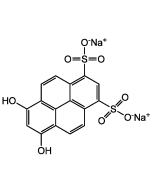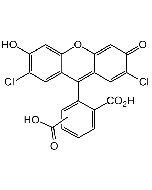Cookie Policy: This site uses cookies to improve your experience. You can find out more about our use of cookies in our Privacy Policy. By continuing to browse this site you agree to our use of cookies.
Chemodex
Phenol red sodium salt

| Product Details | |
|---|---|
| Synonyms | 4,4'-(1,1-Dioxido-3H-2,1-benzoxathiol-3-ylidene)bis-phenol sodium salt |
| Product Type | Chemical |
| Properties | |
| Formula |
C19H13O5S . Na |
| MW | 376.36 |
| CAS | 34487-61-1 |
| Source/Host Chemicals | Synthetic |
| Purity Chemicals | Dye content 90 % (Titration) |
| Appearance | Dark red powder. |
| Solubility | Soluble in water. |
| Identity | Determined by 1H-NMR. |
| Declaration | Manufactured by Chemodex. |
| Other Product Data |
Click here for Original Manufacturer Product Datasheet |
| InChi Key | RBFZWTMVVUVHLM-UHFFFAOYSA-M |
| Smiles | [Na+].OC1=CC=C(C=C1)C(=C1C=CC(=O)C=C1)C1=CC=CC=C1S([O-])(=O)=O |
| Shipping and Handling | |
| Shipping | AMBIENT |
| Short Term Storage | +20°C |
| Long Term Storage | +20°C |
| Handling Advice |
Keep cool and dry. Protect from light and moisture. |
| Use/Stability | Stable for at least 2 years after receipt when stored at +20°C. |
| Documents | |
| MSDS |
 Download PDF Download PDF |
| Product Specification Sheet | |
| Datasheet |
 Download PDF Download PDF |
Water soluble pH indicator used in the 6.8 (yellow) to 8.2 (red) range and frequently used in cell biology laboratories. Widely used as cell tissue culture pH marker. A small amount of phenol red added to the growth medium will have a pink-red color under normal conditions. Typically, 15 mg/l are used for cell culture. In the event of problems, waste products produced by dying cells or overgrowth of contaminants will cause a change in pH, leading to a change in indicator color. For example, a culture of relatively slowly dividing mammalian cells can be quickly overgrown by bacterial contamination. This usually results in an acidification of the medium, turning it yellow. The waste products produced by the mammalian cells themselves will slowly decrease the pH, gradually turning the solution orange and then yellow. This color change is an indication that even in the absence of contamination, the medium needs to be replaced. Shown to be a weak estrogen mimic (possible through inpurities), which can enhance the growth of cells that express the estrogen receptor in cell cultures. Might be useful as a differentiation factor.
(1) F.L. Rodkey; Arch. Biochem. Biophys. 94, 38 (1961) | (2) T. Hoshi & H. Hayashi; Jpn. J. Physiol. 20, 683 (1970) | (3) U. Kragh-Hansen & J.V. Moller; Biochim. Biophys. Acta 295, 438 (1973) | (4) Y. Berthois, et al.; PNAS 83, 2496 (1986) | (5) P. Yuan & D.R. Walt; J. Fluoresc. 2, 231 (1992) | (6) L. Hopp & C.H. Bunker; J. Cell Physiol. 157, 594 (1993) | (7) J. Wesierska-Gadek, et al.; Cell Mol. Biol. Lett. 12, 280 (2007) | (8) H. Lysdahl, et al.; Stem Cell Rev. 9, 132 (2013)














